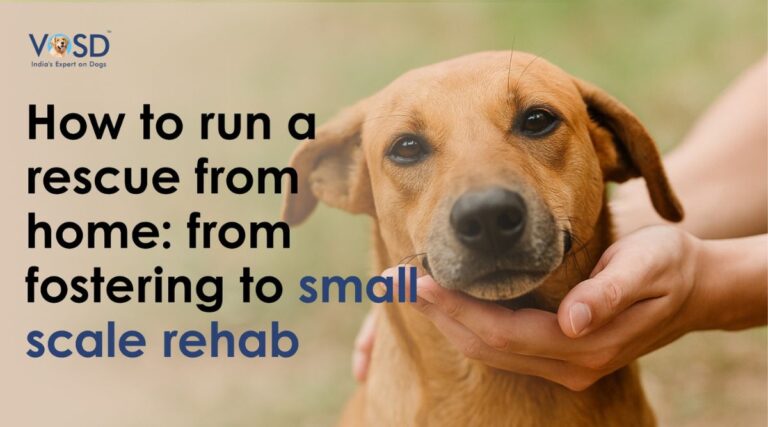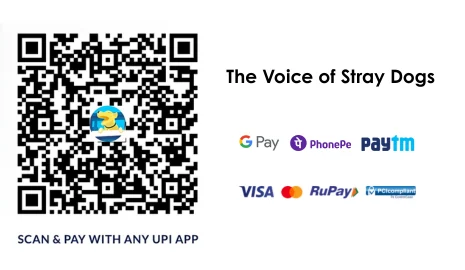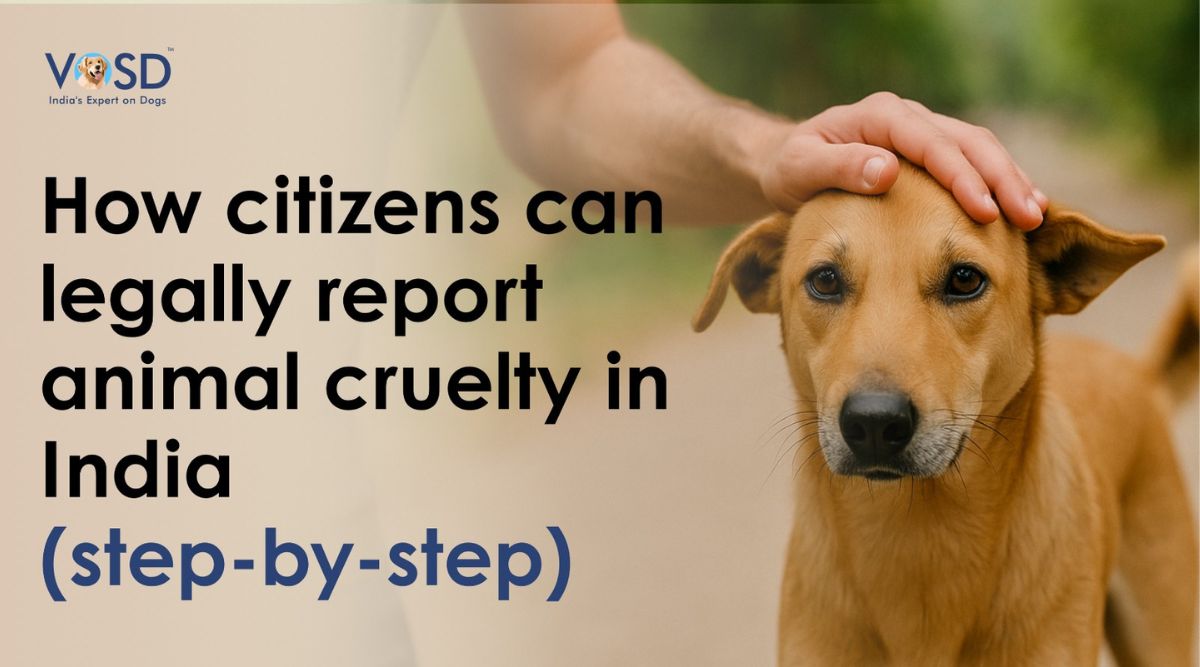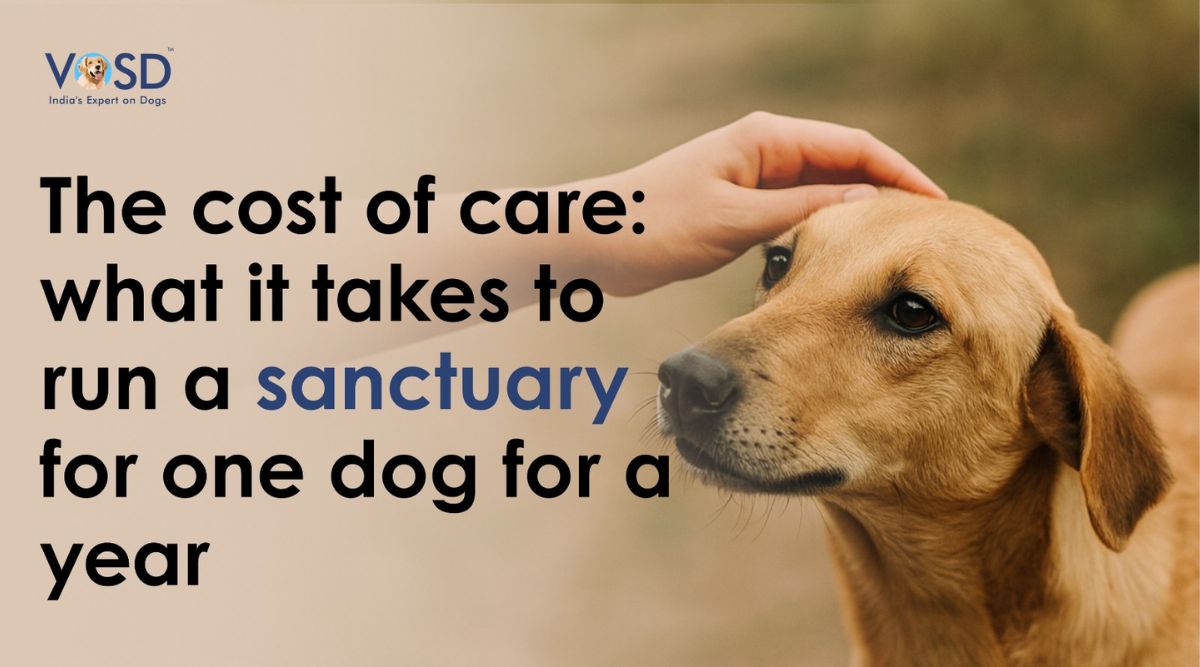India faces a growing challenge of millions of stray dogs and limited shelter space. Municipal facilities and NGOs are often full, leaving many animals without care. That’s where home-based rescues make a real difference, individuals and communities opening their homes to give strays a second chance.
For over a decade, VOSD (Voice of Stray Dogs) has set the gold standard in rescue, rehabilitation, and lifelong care through one of India’s largest dog sanctuaries and hospitals. Drawing from VOSD’s expertise, this guide explains how to set up and sustain a small home-based rescue in India, from mission planning and legal steps to funding and daily care.
A home-based Dog rescue is a compassionate, structured setup where dogs are temporarily fostered, treated medically, and prepared for adoption, supported by experienced organisations like VOSD in Bangalore.
Why Home-Based Rescue Is Critical in India
India faces a massive stray dog crisis, with millions of animals on the streets and limited space in municipal and private shelters. Overcrowded facilities and limited resources mean countless dogs go untreated or unseen.
That’s where home-based rescues step in, turning individual homes into mini care units that expand capacity and compassion.
How Home-Based Rescues Help:
- Relieve shelter overcrowding, freeing up space for critical cases.
- Provide one-on-one care, helping dogs recover faster.
- Lower operational costs through volunteer-driven support.
- Engage communities, fostering empathy and shared responsibility.
VOSD (Voice of Stray Dogs) has proven this model’s power. Its hospital and sanctuary serve as a central hub for medical care, while trained fosters and small home rescues handle recovery and rehabilitation.
Together, this distributed rescue network ensures more dogs receive timely treatment, personal care, and a smoother path to adoption, showing that meaningful animal welfare can truly begin at home.
Defining Your Rescue Mission & Focus
A clear rescue mission defines what you do, who you help, and how you operate. It determines your focus, such as senior dogs, trauma cases, or post-surgery care, and shapes everything from foster recruitment to fundraising and long-term sustainability.
Before starting, outline the core purpose of your rescue. Decide the:
- Type of animals you’ll help (e.g., dogs only or multi-species).
- Care level you can provide medical recovery, behavioural rehab, or adoption prep.
- Capacity limits how many animals your home can safely handle at a time.
For example, a home rescue might focus on post-surgery dogs needing rest after treatment at the VOSD Hospital, or senior dogs who benefit from quiet home care.
If aligned with VOSD, integrate your mission with their ecosystem:
- Use the VOSD Ambulance Fleet for emergency pickups.
- Rely on the VOSD Medical Team for surgeries and diagnostics.
- Share progress reports to maintain unified case tracking.
Finally, decide your operational scope, whether to stay regional (e.g., Bangalore) or gradually expand nationally through a foster network. A well-defined mission ensures you stay focused, avoid burnout, and deliver consistent, high-quality rescue outcomes.
Legal, Zoning & Compliance Essentials for Home-Based Rescues in India
Starting a home-based animal rescue in India requires following key legal, zoning, and welfare regulations. Compliance builds credibility, transparency, and long-term sustainability.
1. Zoning & Local Permissions
Check with your municipal authority to confirm residential rules for housing multiple animals.
- Some areas may require a No Objection Certificate (NOC) from neighbours or housing societies.
- Maintain clean, noise-controlled, and safe conditions to comply with local health and sanitation laws.
2. Registration & Legal Entity
Register your rescue as a non-profit trust or Section 8 company under the Indian Trusts Act or Companies Act (2013).
- This allows you to legally accept donations, open bank accounts, and operate transparently.
- Apply for Section 80G and 12A certifications to provide tax benefits to donors and strengthen legitimacy.
3. Animal Welfare & Care Standards
Follow CPCSEA, Animal Welfare Board of India (AWBI), or municipal animal welfare guidelines.
- Ensure humane living conditions, proper sanitation, and medical care.
- Wildlife rescues require Forest Department permissions, domestic animals like dogs and cats follow separate welfare norms.
How to Set Up the Home Rescue Infrastructure
A successful home-based rescue depends on structure, hygiene, and planning; even small spaces can function efficiently with clear zones, proper sanitation, and organised logistics, keeping rescued dogs healthy, stress-free, and safe.
Essential Layout:
Quarantine Zone: Keep new or sick dogs isolated for 10–14 days to prevent infections.
Rehab Zone: Provide quiet, low-traffic spaces with washable bedding for post-surgery or recovering dogs.
Play/Socialisation Zone: Create open or semi-open areas for exercise and interaction once dogs are medically cleared.
Foster Kits Should Include:
Washable bedding, food and water bowls, leash and muzzle sets, medication tracker sheets, pet-safe disinfectants, first-aid items, and sealed waste bins.
Cleaning & Infection Control:
Clean daily with veterinary-grade disinfectants, sanitise feeding equipment after every use, and rotate bedding twice a week. Always wear gloves when handling medical cases.
Logistics & Transport:
Coordinate rescues through VOSD’s Ambulance Fleet for emergencies and follow-ups, use a triage system where critical cases go to hospitals and stable ones to foster care.
With proper zoning, hygiene, and planning, your home can operate as a safe micro-rescue unit, extending the impact of the VOSD Rescue Network and saving more lives with care and efficiency.
Fostering & Small-Scale Rehabilitation Workflow
How Does the Rescue-to-Adoption Workflow Work?
The ideal home-rescue flow follows a clear path: Intake → Triage at VOSD Hub → Step-Down to Foster → Rehabilitation → Adoption, supported by structured medical, behavioural, and tracking systems. This ensures every rescued dog receives consistent, high-quality care.
A clear workflow helps streamline rescue operations and improve recovery and adoption outcomes. VOSD’s integrated model serves as a practical guide for small-scale rescues and home fosters across India.
1. Intake Process:
Cases are reported via call or online, and the VOSD ambulance team collects the dog and brings it to the hospital for triage.
Immediate Care: Critical or contagious dogs remain at the hospital for treatment or surgery.
Foster-Eligible: Stable, non-contagious dogs move to vetted foster homes for recovery.
2. Foster Tiers:
Tier A – Medical Fosters: Handle post-surgery or medicated dogs under veterinary supervision.
Tier B – Behaviour/Socialisation Fosters: Support fearful or traumatised dogs in regaining trust and confidence.
Tier C – Short-Term Fosters: Provide temporary housing during recovery or before adoption.
3. Rehabilitation Workflow:
Dogs progress from hospital stabilisation to foster care, with daily progress tracking and adoption readiness evaluations. Fosters maintain logs on food, medication, and behaviour.
4. Tele-Vet & Remote Monitoring:
The VOSD veterinary team provides video consultations and follow-ups, ensuring continuous care and reducing unnecessary hospital visits.
5. Adoption Readiness Checklist:
Dogs must be fully vaccinated, sterilized, healthy, and socially confident before joining the VOSD adoption network.
This structured system ensures continuity, accountability, and compassion at every stage, guiding each dog safely from rescue to recovery to rehoming.
Funding, Volunteer Management & Marketing
To sustain a home-based rescue, focus on three essentials: funding, volunteers, and visibility.
Funding:
- Launch small campaigns — “Sponsor a Foster Kit”, “Adopt a Dog’s Medical Care.”
- Partner with corporates and CSR programs for ongoing support.
- Promote VOSD Store products to fund care, shelter, and logistics.
Volunteer Management:
- Recruit through local outreach and social media.
- Offer basic training in feeding, handling, and first aid.
- Recognize efforts with certificates, online mentions, or meet-ups.
- Build a community of consistent, trusted fosters.
Marketing & Outreach:
- Use local SEO and voice search optimization to boost visibility.
- Share real stories, videos, and adoption updates regularly.
- Add geo-tags (e.g., “Dog Rescue in Bangalore”) to attract supporters.
- Track key metrics — adoption rate, volunteer retention, cost per rescue.
In short:
Diversified funding, active volunteers, and digital storytelling make rescues sustainable, visible, and community-powered, helping advance VOSD’s mission across India.
Conclusion: Turning Compassion into Action
A successful home-based rescue thrives on clear purpose, legal structure, proper infrastructure, and strong community support — all achievable with guidance from VOSD (Voice of Stray Dogs).
Starting a rescue from home isn’t just about compassion; it’s about building a structured, sustainable mission that saves lives. From securing legal compliance and setting up safe foster spaces to organising care, funding, and awareness, every step strengthens India’s animal welfare movement.
With VOSD’s proven ecosystem — its hospital, ambulance fleet, sanctuary, and expert team anyone can become part of a nationwide effort to rescue, heal, and protect stray dogs.
Each act of kindness counts. Whether you foster, volunteer, or donate, your contribution expands the reach of this life-saving network, giving every dog a second chance at safety, dignity, and love.
Join the movement — support VOSD today and help build compassionate homes across India.
FAQ
Q: Can I start a home rescue if I work full-time?
Yes. Partner with an established hub like VOSD for emergency triage and focus on low-maintenance or recovering dogs. Keep your intake small and manageable around your schedule.
Q: What if a foster dog becomes aggressive or ill?
Follow the tier system—send medical cases back to the VOSD Hospital for treatment. For behavioral issues, collaborate with certified trainers or request VOSD’s behavioural support for safe rehabilitation.
Q: How much does it cost to foster a dog?
Expenses include food, bedding, and medications. Through VOSD’s “Sponsor a Foster Kit” program, donors can offset most costs for foster homes.
Q: How do I find adoptive homes from a home-based rescue?
Use a simple application, interview, and home-check process, then promote through VOSD’s adoption network and social media to reach vetted adopters.
Q: Is fostering in a home legal in India?
Absolutely. As long as you follow BBMP guidelines, maintain hygiene, and partner with a registered rescue like VOSD, home fostering is fully lawful and impactful.








